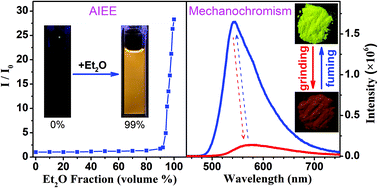Aggregation-induced emission enhancement and reversible mechanochromic luminescence of quinoline-based zinc(ii)–Schiff base complexes†
Abstract
Three quinoline-based zinc(II)–Schiff base complexes were synthesized and characterized by X-ray crystallography. They exhibit remarkable aggregation-induced emission enhancement (AIEE) in acetonitrile/diethyl ether mixtures due to the conversion of weak luminescence in homogeneous solution into strong emission in the nano-aggregated phase after increasing the fractions of diethyl ether. Interestingly, the AIEE performance can be significantly promoted by joining the two quinoline units through an alkoxy chain. Moreover, they show reversible mechanochromic luminescence behavior between dark and bright states during the grinding–fuming cycles, due to the modulation of morphologies between amorphous and crystalline states. Introducing an electron donating group in the para-position of aniline significantly improves the mechanochromic luminescence effect with a more accessible and distinct emission colour contrast. The molecular packing in the crystalline phase and time-dependent density functional theory (TD-DFT) calculations demonstrate that multiple intermolecular C–H⋯π and π–π interactions significantly strengthen the molecular rigidity and enhance the intramolecular charge-transfer (ICT) characteristics, leading to the effective emission enhancement in crystalline/nano-aggregated states. The novel AIEE and reversible mechanochromic luminescence properties point to the promising potential applications of these complexes in smart fluorescent materials.



 Please wait while we load your content...
Please wait while we load your content...